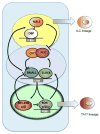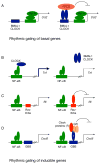Immunity around the clock
- PMID: 27885005
- PMCID: PMC5247264
- DOI: 10.1126/science.aah4966
Immunity around the clock
Abstract
Immunity is a high-cost, high-benefit trait that defends against pathogens and noxious stimuli but whose overactivation can result in immunopathologies and sometimes even death. Because many immune parameters oscillate rhythmically with the time of day, the circadian clock has emerged as an important gatekeeper for reducing immunity-associated costs, which, in turn, enhances organismal fitness. This is mediated by interactions between extrinsic environmental cues and the intrinsic oscillators of immune cells, which together optimize immune responses throughout the circadian cycle. The elucidation of these clock-controlled immunomodulatory mechanisms might uncover new approaches for treating infections and chronic inflammatory diseases.
Copyright © 2016, American Association for the Advancement of Science.
Figures




References
Publication types
MeSH terms
Substances
Grants and funding
LinkOut - more resources
Full Text Sources
Other Literature Sources

